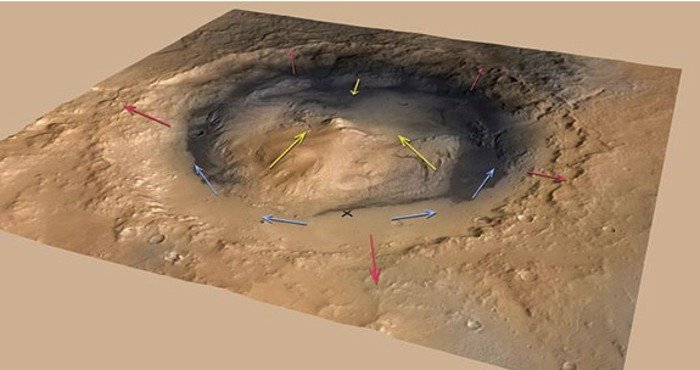The researchers report that air would have flowed up the crater rim in the morning when the surface warmed, and reversed in the cooler late afternoon. A computer model showed fine dust carried by these winds could accumulate over time to build a mound the size of Mount Sharp even if the ground were bare from the start. Credit: NASA/JPL-Caltech/ESA/DLR/FU Berlin/MSSS)
PRINCETON, N.J., May 6 (UPI) -- A martian mountain scientists suspect preserves evidence of a massive lake might actually have been formed by wind, not water, U.S. scientists say.
Researchers at Princeton University and the California Institute of Technology suggest the 3.5-mile-high mound known as Mount Sharp most likely emerged as strong winds carried dust and sand into the 96-mile-wide crater in which it sits.
If correct, the finding could dilute expectations the mound holds evidence of a large body of water, which would have important implications for understanding Mars' past habitability, a Princeton release said Monday.
Writing in the Journal Geology, the researchers said air probably rises out of the massive Gale Crater into the Red Planet's famously dusty atmosphere when the martian surface warms during the day, then sweeps back down its steep walls at night but would die when they reach the crater's center, allowing fine dust to settle and accumulate over eons, forming Mount Sharp.
This theory goes against a prevailing theory that Mount Sharp formed from layers of lake bed silt, and would mean the mound contains less evidence of a past, Earth-like martian climate than most scientists currently expect, the researchers said.
"Our work doesn't preclude the existence of lakes in Gale Crater, but suggests that the bulk of the material in Mount Sharp was deposited largely by the wind," Princeton geosciences researcher Kevin Lewis said.
Even if wind and not water formed the mound, it's a geologically valuable research target, he said.
"This is how we learn about Earth's history, by finding the most complete sedimentary records we can and going through layer by layer. One way or another, we're going to get an incredible history book of all the events going on while that sediment was being deposited," he said.
"I think Mount Sharp will still provide an incredible story to read. It just might not have been a lake."















